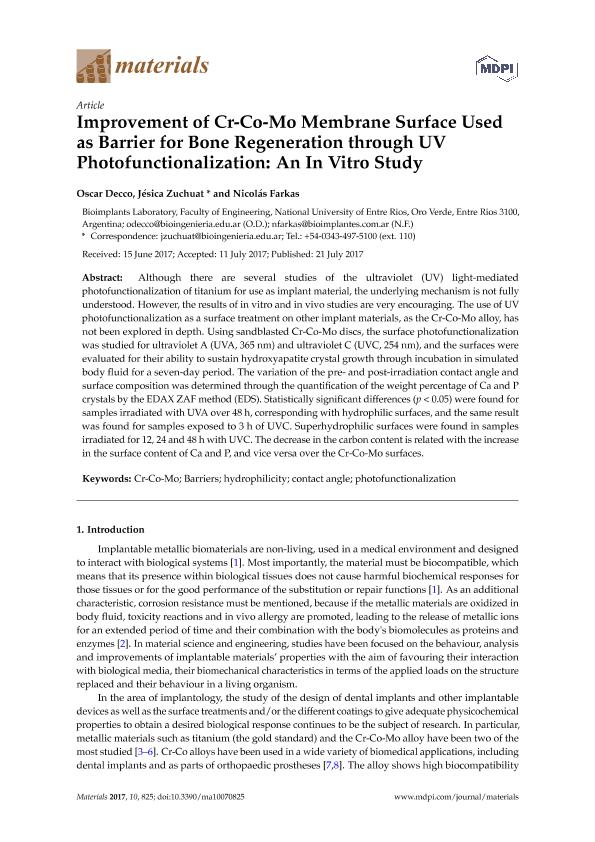Artículo
Improvement of Cr-Co-Mo membrane surface used as barrier for bone regeneration through UV photofunctionalization: An in vitro study
Fecha de publicación:
07/2017
Editorial:
MDPI AG
Revista:
Materials
ISSN:
1996-1944
Idioma:
Inglés
Tipo de recurso:
Artículo publicado
Clasificación temática:
Resumen
Although there are several studies of the ultraviolet (UV) light-mediated photofunctionalization of titanium for use as implant material, the underlying mechanism is not fully understood. However, the results of in vitro and in vivo studies are very encouraging. The use of UV photofunctionalization as a surface treatment on other implant materials, as the Cr-Co-Mo alloy, has not been explored in depth. Using sandblasted Cr-Co-Mo discs, the surface photofunctionalization was studied for ultraviolet A (UVA, 365 nm) and ultraviolet C (UVC, 254 nm), and the surfaces were evaluated for their ability to sustain hydroxyapatite crystal growth through incubation in simulated body fluid for a seven-day period. The variation of the pre- and post-irradiation contact angle and surface composition was determined through the quantification of the weight percentage of Ca and P crystals by the EDAX ZAF method (EDS). Statistically significant differences (p < 0.05) were found for samples irradiated with UVA over 48 h, corresponding with hydrophilic surfaces, and the same result was found for samples exposed to 3 h of UVC. Superhydrophilic surfaces were found in samples irradiated for 12, 24 and 48 h with UVC. The decrease in the carbon content is related with the increase in the surface content of Ca and P, and vice versa over the Cr-Co-Mo surfaces.
Palabras clave:
Barriers
,
Contact Angle
,
Cr-Co-Mo
,
Hydrophilicity
,
Photofunctionalization
Archivos asociados
Licencia
Identificadores
Colecciones
Articulos(SEDE CENTRAL)
Articulos de SEDE CENTRAL
Articulos de SEDE CENTRAL
Citación
Decco, Oscar Alfredo; Zuchuat, Jésica Itatí; Farkas, Nicolás; Improvement of Cr-Co-Mo membrane surface used as barrier for bone regeneration through UV photofunctionalization: An in vitro study; MDPI AG; Materials; 10; 7; 7-2017; 1-13
Compartir
Altmétricas




